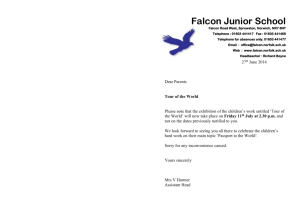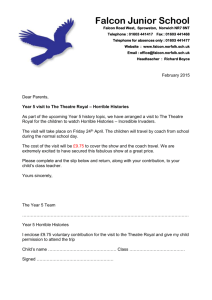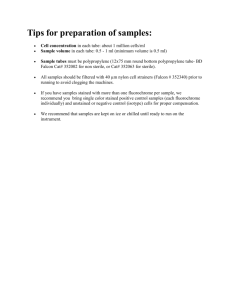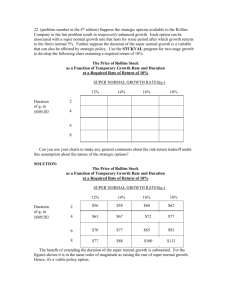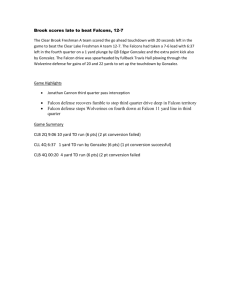Flight of the Navigator
advertisement
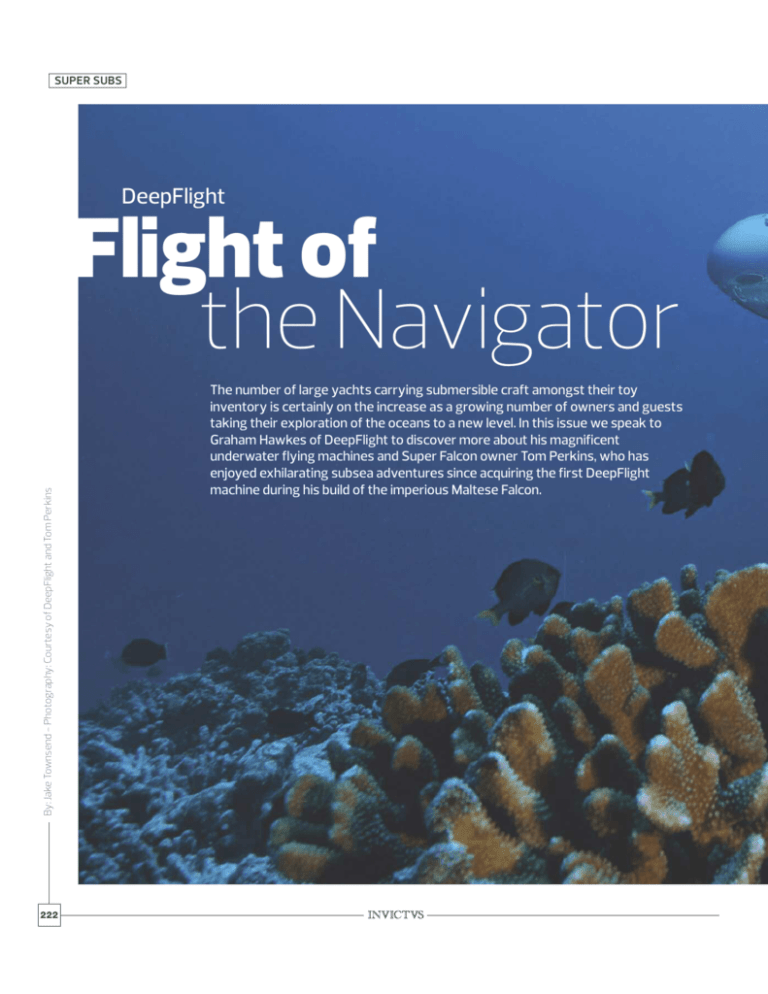
SUPER SUBS DeepFlight By: Jake Townsend - Photography: Courtesy of DeepFlight and Tom Perkins Flight of the Navigator 222 The number of large yachts carrying submersible craft amongst their toy inventory is certainly on the increase as a growing number of owners and guests taking their exploration of the oceans to a new level. In this issue we speak to Graham Hawkes of DeepFlight to discover more about his magnificent underwater flying machines and Super Falcon owner Tom Perkins, who has enjoyed exhilarating subsea adventures since acquiring the first DeepFlight machine during his build of the imperious Maltese Falcon. SUPER SUBS 223 SUPER SUBS T Though it is often to the stars that we look when considering undiscovered frontiers, it is easy to overlook that vast mystery that covers the majority of our planet and yet remains unknown to all but a handful of our species. Even for those whose love for our oceans calls them to water’s surface, what lies beneath the waves is largely out of reach due to constraints of both physiology and technology– unless of course, you’re Graham Hawkes; engineer, inventor, entrepreneur and owner of DeepFlight Submarines, whose underwater craft are among the most advanced and exciting personal submarines on the market. First having come to public attention on the decks of Tom Perkins’ legendary sailing yacht The Mal224 When asked about the motivation behind his designing such a dynamic submersible, Hawke told u: "I wanted to swim with the big animals." tese Falcon, these sleek, winged machines are more aircraft than submersible in spirit. Designed to ‘fly’ underwater, Hawkes’ inventions have pushed at the boundaries of a largely unchanged submersible technological landscape, and have brought dimension to the underwater exploration and recreation experience. There is simply no other underwater craft that matches those produced by DeepFlight. With the recent announcement of DeepFlight’s newest submarine, the Dragon, the company’s innovative array of personal underwater craft is now undeniably unlike anything on the commercial market. Hawkes’ subs glide through the water, allowing for maneuverability and control that make contact with our oft hidden undersea life easier than was SUPER SUBS previously imagined. “I wanted to fly with the big animals,” says Hawkes of the impetus to devote his life’s work to these aquatic airplanes. And fly he has: Hawkes is rife with tales of adventure in his craft that includes encounters with all manner of sea creature including a graceful aquatic dance with a giant female manta ray, and a very close encounter with a great white shark in Mexico-- the latter with Sir Richard Branson as co-pilot. Having begun his career working at a defense contractor, Graham Hawkes was on course to later markedly influence submarine technology and perception. “Immediately after college I ended up with a defense contractor working for the Royal Navy where I was involved with special manned submersibles for military,” says Hawkes. His work soon began to focus on designing and building innovative submersible craft for offshore oil and gas exploration and development—mainly used in North Sea. Until Graham Hawkes, submarine design and technology in general focused on submerging a craft to depth, with little attention paid to maneuverability save for the most rudimentary of capabilities. Subs could go up and down, forward and backward: Graham Hawkes wanted to fly—but first he had to sink. “As it was with Chuck Yeager,” Hawkes explains, “they needed a small craft to break the sound barrier–our first breakthrough to underwater flight was called DeepFlight 1.” 225 SUPER SUBS It was when Steve Fossett, the late American businessman and adventurer, called on Hawkes and Hawkes Ocean Technologies to design a potentially record-breaking submersible, dubbed “Challenger Deep”, that would take Fossett 37,000 feet to the bottom of sea-- the lowest recorded depth at solo. Though Fossett perished in an unrelated accident before the Challenger Deep was put to the test, Richard Branson and his company Virgin Oceanic, later purchased the craft and are still the owners today. Though a well-known film director managed to break the official record before the Challenger could, Hawkes is satisfied that he created a techno226 Graham Hawkes returns from a dive with Richard Branson in Mexico, during which they enjoyed an encounter with a large Great White shark. logically superior craft that is still very much up to the challenge. Branson is now committed to diving to the ocean’s five deepest points in the Challenger. Hawkes, however, had bigger goals in mind. “I was looking for new challenges,” says Hawkes, “Up until the Challenger Deep, my biggest challenge was getting to bottom of the ocean for science. Most subs are launched from the surface, sink straight down and wiggle around a little bit at the bottom. The ocean is a three dimensional space, however; a submersible craft should take advantage of this.” It was this innovative thinking that lead to the development of Hawkes’ underwater “airplanes”, and SUPER SUBS Though not available to contribute to this feature at the time of going to press, Dietrich Mateschitz –founder of Red Bull energy drink company– and his family are obviously enjoying their time with their new Super Falcon at their private island in Fiji. 227 SUPER SUBS TOM PERKINS: THE FALCON AND DR. NO. There is no one quite like Tom Perkins: he is one of America’s leading businessmen, the father of venture capitalism, a groundbreaking engineer, an adventurer, certainly a raconteur—a sometime writer— and unsurprisingly, the very first person to purchase a Super Falcon for private use. Perkins’ leadership in Silicon Valley, including pivotal roles at SpectraPhysics, Hewlett Packard and Genentech among others, may have made him his fortune, but it is his taste for adventure and eye for the very best that sets him apart from other visionary business leaders. “Graham (Hawkes) had built a prototype of the Super Falcon,” says Perkins, recounting his first encounter with the craft. “I took one look at it and instantly knew how it worked—though I had no interest in buying the thing I was looking at; it was crude.” But Perkins was intrigued, and later visited Hawkes at his Northern California headquarters where it took under an hour for the two men to come to agreement: two Super Falcons would be built simultaneously, the first one going to Mr. Perkins, of course. Graham would have to settle on the second, the Super Falcon II. Perkins’ Super Falcon was, in many ways, a perfect fit for another famous Falcon, this one the world’s largest sailing yacht “The Maltese Falcon”, which at the time had only recently been completed. It has since been sold, “at a profit,” Perkins mentions in recounting the story. Though Tom Perkins is well known for his business acumen, The Maltese Falcon is a testament to his engineering genius. The yacht is still one of the most advanced ever built, and entirely designed and built by the man himself. “I did it to prove that it could be done,” he says of the extraordinary ship. “I was the contractor, I managed the project myself, I designed the sailing system and the widgets, I wrote the software-- I spent years designing it.” 228 SUPER SUBS puts Graham Hawkes in a league of his own. With this evolution of undersea exploration in mind, Hawkes utilized the sum of his vast knowledge of submersible design and engineering, beginning with its early military application, then industrial use, its application in science and exploration and finally, for the pure satisfaction and joy of flying through the ocean’s vast blue underworld. “Up until we created the Super Falcon, there was no market for submersibles other than for government use; following the Challenger, I decided that I would build a craft that I wanted-- not for anyone else,” he says. “With the DeepFlight and all of our craft, you don’t sink to the seabed and look at a crab-- you’re flying in beautiful blue space with a shark or a whale. You are truly in a different world.” Now producing underwater craft several generations removed from the first, ‘experimental’ underwater flying subs, Hawkes’ inventions have created a new kind of transportation—and inspired an entirely new way to think about our interaction and travel underwater. “If you are seeking adventure and your own satisfaction, then the best thing you can hope for is to have encounters underwater with the big animals: whales, manta rays and sharks. We have done that. Those experiences blow your mind.” The result of Hawkes’ passionate pursuit was the Super Falcon, the 4th generation of his flying submarines. “The Super Falcon is where we perfected everything—I’m still in love with it,” says Hawkes. The design, which does indeed look like a small fixed wing aircraft, is striking; so much so that when Tom For anyone who has seen her in person, with its gleaming carbon fiber hull and towering masts, there is no doubt of his mastery of the medium. He also has a great sense of humor: while still in his possession, nautical flags spelled out the message, "Rarely does one have the privilege to witness vulgar ostentation on such a grand scale." It isn’t known whether her new owners had the gumption to keep the missive. Given pride of place on the foredeck of the groundbreaking vessel, the Super Falcon was companion to many of Perkins’ adventurers in seas around the world. “It is enormous fun,” he says of the sub. “It’s really an underwater airplane; you can dive it straight down, go straight up, do rolls and aerobatics-you scare the wits out of people when you do that – it’s a lot of fun to be ten to fifteen feet below surface, to see all of the marine life.” He used the sub in the Caribbean, in Mexico and later extensively in the South Pacific, where the sub found a new home on Perkins’ latest vessel, now up for sale, Dr. No—a 37- meter converted military vessel that Perkins and crew used to explore the seas around Palau, Tahiti, Australia, New Caledonia and the Kingdom of Tonga, where he famously became the first human being to dive with Humpback whales at depth—in the Super Falcon, of course. “Because it hadn’t been done before,” he says, “ we didn’t know if they would flee, or even attack—it turned out they were very curious. They came close to us and saw that we were people; they did ballets for us; it was quite exciting.” Perkins estimates that he’s logged between 120 and 130 hours in his Super Falcon, “and has never had any operational problems.” After nearly four years worth of adventures, he’s recently put Dr. No up for sale, and with it, the Super Falcon. Now, instead of seeing him gliding into the sea in his submarine, you might catch a glimpse of him speeding along Northern California’s highways in his recently delivered Pagani Huayra— the very first in the United States. “It’s an incredible car—a pure sports car,” he says. And he would know. 229 SUPER SUBS PILOTING SUPER FALCON CPT. CHRISTIAN TRUTER: MASTER OF DR. NO Having explored many places around the world with Super Falcon, we were excited by the amazing conditions and oceanography of French Polynesia. Our first day of Submarine operations off Anse Amyot was particularly memorable. It dawned clear with no wind and a tiny swell on the outer reef. I was to be on the first dive with Mr.P and after our pre-dive check we were towed by the tender out of the pass towards the gin clear water of the Pacific. Our first dive took us north at a depth around 100 to 130’ (30-40m) through schools of reef fish and sharks. After about 30-minutes we took the Falcon down the wall and into the darker waters. Along this wall we found a large chain of marine caves at around 60-80 meters, these caves may never have been seen by man before as they lie in water no often dived and never at this depth. It is a remarkable thing to see something and know you are first. Soon we were back at the pass and after flying in entrance through schools of feeding fish we surfaced and were towed back to Dr.No. After a quick lunch we managed two more dives before the light faded and the deep water turned an inky black. The next morning the wind was again light and the sea flat. So we jumped straight in to the Super Falcon and explored the wall to the south of the pass. In the south there were no more caves but we did spend several minutes traversing a school of pelagic trigger fish (the biggest school I have ever seen and anyone that I have talked to about it have ever heard of). We then headed back to the pass to fly along the edge of the drop-off with the sharks and barracuda. At the entrance we had a wonderful flight in congress with a huge 230 "We peered into a chain of marine caves no human had previously cast eyes on..." Perkins, founder of legendary Silicon Valley venture capital firm Kleiner Perkins Caulfield and Buyers and designer of the world’s largest sailing yacht, saw it at the Monaco Yacht Show, he was intrigued enough to later pay Graham a visit at his San Francisco-area headquarters. “Tom wanted a submarine for himself,” says Graham, “and wanted something that no one had. If anyone can find what is the most cutting edge, it is going to be Tom.” After showing Perkins the Super Falcon design on the computer, his decision was almost instantaneous. “He wanted the first one and he didn’t want to wait, so we built two together: Tom had first one, I had the second.” Perkin’s Super Falcon I brought new attention to the firm, as the sub was given pride of place on the foredeck of The Maltese Falcon (the similar names are coincidental), where it was put to great use (see sidebar). Perkins was so enamored of the craft that, even after selling The Maltese Falcon, he purchased a second boat, Dr. No, and retrofitted it specifically SUPER SUBS So enamored was Tom Perkins with his Super Falcon, that after selling Maltese Falcon he acquired Dr. No and had her refitted specifically to allow for the continuation of his subaquatic adventures. to afford its continuing use. Before the Super Falcon series, and now with the new Dragon, any personal submersible required a crew to both maintain and operate it. “Our craft have a very tough set of requirements,” Hawkes says. “You aren’t going to have a specialized crew of submariners on board—the craft have to be used by a yacht crew. We had already built for military; our military craft are equally as complex as those built for the commercial market—they simply can’t afford to fail—so you have to deal with things quite differently. Reliability is imperative. Our craft will be used by non- experts—previously subs came with the crew of people who built them, but that wasn’t going to happen anymore.” Both models fit two people, one behind the other, with 360-degree views courtesy of the signature acrylic domes that surround both pilot and passenger. Powered by rechargeable underwater lithium ion batteries, and designed to give off minimal electrical charge so as not to repel sensitive underwater creatures, the subs are able to operate for nearly 6 hours at a time. The low frequency electrical output coupled with extremely silent mechanics and propulsion allow for enhanced interaction and minimal disturbance to undersea life. Talk to anyone who has owned or operated either a Super Falcon or the new Dragon and stories of very close encounters with large marine animals are common. After Tom Perkins came Richard Branson for second time, who purchased a Super Falcon, and then most recently Red Bull founder Dietrich Mateschitz, whose Super Falcon Hawkes delivered to an undisclosed location in Fiji. eagle ray for a few minutes before surfacing and heading back to the yacht– ‘the good doctor’, Dr. No. When Mr.P cooked up the plan for the Dr. No project, one of the primary goals was to fly the Super Falcon submarine with whales. Later this developed into a plan to film whales from the Super Falcon with hope to watch and record behaviors not previously witnessed. As a concept it does not appear that hard. Step 1: Take Super Falcon to the whales. Step 2: Fly with whales. Step 3: Record. Sounds easy…. Well after a year of preparation it all started to come together when 45lb (20kg) of camera equipment arrived on Dr. No in Denarau, Fiji, prior to our departure for Tonga and our search for whales. In order to film–after much debate and discussion–we settled on a new Nikon D-4 camera in a Nauticam housing to be mounted on the nose of the Super Falcon (Falcon) and remote controlled via Ethernet on a tablet in the rear cockpit. On arrival in Vavau we enjoyed several encounters with whales, but whilst there are many in the Vavau group there is also a lot of territory and they don’t hang about. On the morning of the 19th however we moved location and conditions were perfect. There were whales around but very far off. Around 11am a group of four whales started to head towards the Dr., so the decision was made to launch the Falcon and tow it towards the Whales. When the Falcon was 100-yards from the resting group the tow was released and the Falcon flew at 130’ below the tender towards the group. At first there was just the sapphire blue Pacific, but slowly great dark shapes emerged and then took form. We were doing it! We were flying a twoman submersible with humpback whales in their domain, the open blue! The first dive of the day was the most successful with 3-4 minutes cruising with a group consisting of a mother and calf and two escort males at around 130’ depth. One of the escort males inspected the Falcon closely and then on an agreed impulse the four giant mammals moved out of view… but a first had been achieved. Never before had a powered submersible flown in close proximity to Humpback whales, but Super Falcon had–and we have the footage to prove it. 231 SUPER SUBS 232 SUPER SUBS If the Super Falcon is akin to flying an airplane, the Dragon is akin to flying a helicopter—albeit a helicopter that virtually anyone can learn to fly in just a few hours. “For those who are adventurous or have a love of flying- they will choose the Super Falcon. It takes a couple of days to learn to fly it,” says Hawkes. “For those who are looking to do normal exploration, and want ease of use, they would choose the Dragon. Even your guests can just jump in and drive the thing!” Among other advancements, the Dragon can hover like a helicopter allowing for relaxed underwater exploration—if you want to “play with whales,” as Graham says, then the Super Falcon is your craft of choice. Like all of Hawke’s subs, the Super Falcon Mark I and Mark II and the Dragon are positively buoyant, making them quite safe. Conventional submersibles use ballast to descend, meaning the default motion is to sink; DeepFlight subs are the opposite. A built in fail safe mechanism insures automatic returns to the surface if anything goes awry. “The Falcon can be dived straight down or straight up vertically and your ears don’t feel a thing because the pressure hull holds back the water,” says Hawkes—a remarkable feat of engineering that is rather surprising to anyone who has had previous experience SCUBA diving. The Super Falcon can be charged overnight and is ready for a whole days use, the Dragon is capable of rapid charging. Oxygen is supplied by medical or aircraft grade oxygen tanks, which are carried externally. A microcomputer controls life support and the constantly- refreshed atmosphere, which is much like those used on a spacecraft. Piloting both craft is very simple— owners are always encouraged to enjoy being at the helm of their own sub. There are two seats, but “you don’t need a professional pilot; you don’t buy a Ferrari and give the keys to a chauffeur. You are going to drive or fly it by yourself!” Hawkes exclaims. The fly- by- wire controls allow for intuitive operation—and can easily be learned in an afternoon. On your left hand is a throttle and on the right is a small fly by wire joystick; with your left hand as you advance, the Dragon will dive; when you pull back to the mid point, it will hover, and when you pull back, you will rise. It really is as simple as that. A microcomputer takes care of safety, making sure that you don’t go too deep or too close to surface. However, this is not a hands off experience: the owner is flying the craft, but safety systems will advise if any adjustments to depth or speed need to be made. Says Hawkes: “I have had the pleasure of taking kids and kings underwater and everyone leaves with a huge smile on their face” The Super Falcon is priced at USD 1.7 million, the Dragon is slightly less at USD 1.5 million. Both craft take 9 months to complete.
